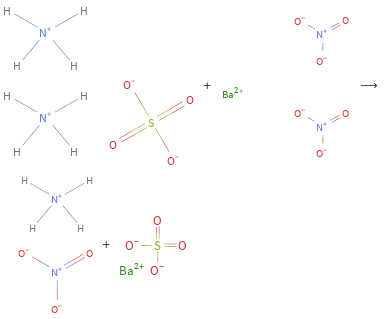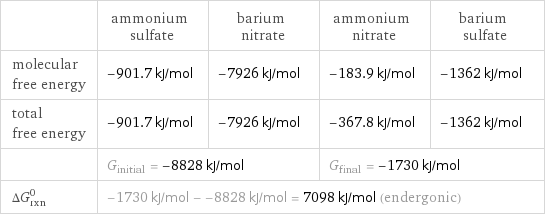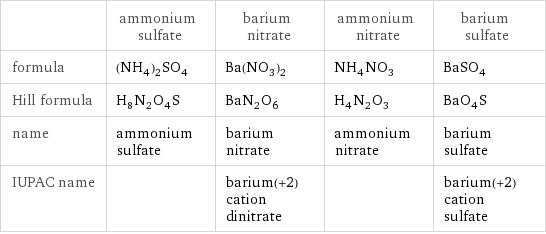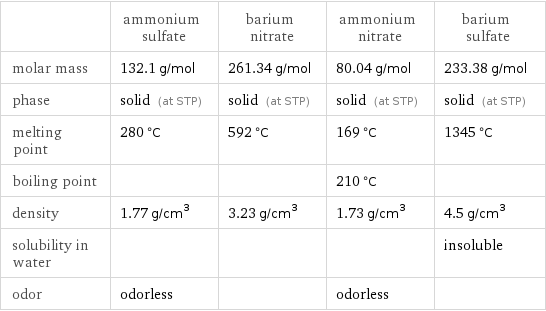Input interpretation

(NH_4)_2SO_4 ammonium sulfate + Ba(NO_3)_2 barium nitrate ⟶ NH_4NO_3 ammonium nitrate + BaSO_4 barium sulfate
Balanced equation

Balance the chemical equation algebraically: (NH_4)_2SO_4 + Ba(NO_3)_2 ⟶ NH_4NO_3 + BaSO_4 Add stoichiometric coefficients, c_i, to the reactants and products: c_1 (NH_4)_2SO_4 + c_2 Ba(NO_3)_2 ⟶ c_3 NH_4NO_3 + c_4 BaSO_4 Set the number of atoms in the reactants equal to the number of atoms in the products for H, N, O, S and Ba: H: | 8 c_1 = 4 c_3 N: | 2 c_1 + 2 c_2 = 2 c_3 O: | 4 c_1 + 6 c_2 = 3 c_3 + 4 c_4 S: | c_1 = c_4 Ba: | c_2 = c_4 Since the coefficients are relative quantities and underdetermined, choose a coefficient to set arbitrarily. To keep the coefficients small, the arbitrary value is ordinarily one. For instance, set c_1 = 1 and solve the system of equations for the remaining coefficients: c_1 = 1 c_2 = 1 c_3 = 2 c_4 = 1 Substitute the coefficients into the chemical reaction to obtain the balanced equation: Answer: | | (NH_4)_2SO_4 + Ba(NO_3)_2 ⟶ 2 NH_4NO_3 + BaSO_4
Structures

+ ⟶ +
Names

ammonium sulfate + barium nitrate ⟶ ammonium nitrate + barium sulfate
Reaction thermodynamics
Gibbs free energy

| ammonium sulfate | barium nitrate | ammonium nitrate | barium sulfate molecular free energy | -901.7 kJ/mol | -7926 kJ/mol | -183.9 kJ/mol | -1362 kJ/mol total free energy | -901.7 kJ/mol | -7926 kJ/mol | -367.8 kJ/mol | -1362 kJ/mol | G_initial = -8828 kJ/mol | | G_final = -1730 kJ/mol | ΔG_rxn^0 | -1730 kJ/mol - -8828 kJ/mol = 7098 kJ/mol (endergonic) | | |
Equilibrium constant
![Construct the equilibrium constant, K, expression for: (NH_4)_2SO_4 + Ba(NO_3)_2 ⟶ NH_4NO_3 + BaSO_4 Plan: • Balance the chemical equation. • Determine the stoichiometric numbers. • Assemble the activity expression for each chemical species. • Use the activity expressions to build the equilibrium constant expression. Write the balanced chemical equation: (NH_4)_2SO_4 + Ba(NO_3)_2 ⟶ 2 NH_4NO_3 + BaSO_4 Assign stoichiometric numbers, ν_i, using the stoichiometric coefficients, c_i, from the balanced chemical equation in the following manner: ν_i = -c_i for reactants and ν_i = c_i for products: chemical species | c_i | ν_i (NH_4)_2SO_4 | 1 | -1 Ba(NO_3)_2 | 1 | -1 NH_4NO_3 | 2 | 2 BaSO_4 | 1 | 1 Assemble the activity expressions accounting for the state of matter and ν_i: chemical species | c_i | ν_i | activity expression (NH_4)_2SO_4 | 1 | -1 | ([(NH4)2SO4])^(-1) Ba(NO_3)_2 | 1 | -1 | ([Ba(NO3)2])^(-1) NH_4NO_3 | 2 | 2 | ([NH4NO3])^2 BaSO_4 | 1 | 1 | [BaSO4] The equilibrium constant symbol in the concentration basis is: K_c Mulitply the activity expressions to arrive at the K_c expression: Answer: | | K_c = ([(NH4)2SO4])^(-1) ([Ba(NO3)2])^(-1) ([NH4NO3])^2 [BaSO4] = (([NH4NO3])^2 [BaSO4])/([(NH4)2SO4] [Ba(NO3)2])](../image_source/5f2ad152272861123b15b19e6392b019.png)
Construct the equilibrium constant, K, expression for: (NH_4)_2SO_4 + Ba(NO_3)_2 ⟶ NH_4NO_3 + BaSO_4 Plan: • Balance the chemical equation. • Determine the stoichiometric numbers. • Assemble the activity expression for each chemical species. • Use the activity expressions to build the equilibrium constant expression. Write the balanced chemical equation: (NH_4)_2SO_4 + Ba(NO_3)_2 ⟶ 2 NH_4NO_3 + BaSO_4 Assign stoichiometric numbers, ν_i, using the stoichiometric coefficients, c_i, from the balanced chemical equation in the following manner: ν_i = -c_i for reactants and ν_i = c_i for products: chemical species | c_i | ν_i (NH_4)_2SO_4 | 1 | -1 Ba(NO_3)_2 | 1 | -1 NH_4NO_3 | 2 | 2 BaSO_4 | 1 | 1 Assemble the activity expressions accounting for the state of matter and ν_i: chemical species | c_i | ν_i | activity expression (NH_4)_2SO_4 | 1 | -1 | ([(NH4)2SO4])^(-1) Ba(NO_3)_2 | 1 | -1 | ([Ba(NO3)2])^(-1) NH_4NO_3 | 2 | 2 | ([NH4NO3])^2 BaSO_4 | 1 | 1 | [BaSO4] The equilibrium constant symbol in the concentration basis is: K_c Mulitply the activity expressions to arrive at the K_c expression: Answer: | | K_c = ([(NH4)2SO4])^(-1) ([Ba(NO3)2])^(-1) ([NH4NO3])^2 [BaSO4] = (([NH4NO3])^2 [BaSO4])/([(NH4)2SO4] [Ba(NO3)2])
Rate of reaction
![Construct the rate of reaction expression for: (NH_4)_2SO_4 + Ba(NO_3)_2 ⟶ NH_4NO_3 + BaSO_4 Plan: • Balance the chemical equation. • Determine the stoichiometric numbers. • Assemble the rate term for each chemical species. • Write the rate of reaction expression. Write the balanced chemical equation: (NH_4)_2SO_4 + Ba(NO_3)_2 ⟶ 2 NH_4NO_3 + BaSO_4 Assign stoichiometric numbers, ν_i, using the stoichiometric coefficients, c_i, from the balanced chemical equation in the following manner: ν_i = -c_i for reactants and ν_i = c_i for products: chemical species | c_i | ν_i (NH_4)_2SO_4 | 1 | -1 Ba(NO_3)_2 | 1 | -1 NH_4NO_3 | 2 | 2 BaSO_4 | 1 | 1 The rate term for each chemical species, B_i, is 1/ν_i(Δ[B_i])/(Δt) where [B_i] is the amount concentration and t is time: chemical species | c_i | ν_i | rate term (NH_4)_2SO_4 | 1 | -1 | -(Δ[(NH4)2SO4])/(Δt) Ba(NO_3)_2 | 1 | -1 | -(Δ[Ba(NO3)2])/(Δt) NH_4NO_3 | 2 | 2 | 1/2 (Δ[NH4NO3])/(Δt) BaSO_4 | 1 | 1 | (Δ[BaSO4])/(Δt) (for infinitesimal rate of change, replace Δ with d) Set the rate terms equal to each other to arrive at the rate expression: Answer: | | rate = -(Δ[(NH4)2SO4])/(Δt) = -(Δ[Ba(NO3)2])/(Δt) = 1/2 (Δ[NH4NO3])/(Δt) = (Δ[BaSO4])/(Δt) (assuming constant volume and no accumulation of intermediates or side products)](../image_source/75e173c8f57aa1bac3b927448c8c7e59.png)
Construct the rate of reaction expression for: (NH_4)_2SO_4 + Ba(NO_3)_2 ⟶ NH_4NO_3 + BaSO_4 Plan: • Balance the chemical equation. • Determine the stoichiometric numbers. • Assemble the rate term for each chemical species. • Write the rate of reaction expression. Write the balanced chemical equation: (NH_4)_2SO_4 + Ba(NO_3)_2 ⟶ 2 NH_4NO_3 + BaSO_4 Assign stoichiometric numbers, ν_i, using the stoichiometric coefficients, c_i, from the balanced chemical equation in the following manner: ν_i = -c_i for reactants and ν_i = c_i for products: chemical species | c_i | ν_i (NH_4)_2SO_4 | 1 | -1 Ba(NO_3)_2 | 1 | -1 NH_4NO_3 | 2 | 2 BaSO_4 | 1 | 1 The rate term for each chemical species, B_i, is 1/ν_i(Δ[B_i])/(Δt) where [B_i] is the amount concentration and t is time: chemical species | c_i | ν_i | rate term (NH_4)_2SO_4 | 1 | -1 | -(Δ[(NH4)2SO4])/(Δt) Ba(NO_3)_2 | 1 | -1 | -(Δ[Ba(NO3)2])/(Δt) NH_4NO_3 | 2 | 2 | 1/2 (Δ[NH4NO3])/(Δt) BaSO_4 | 1 | 1 | (Δ[BaSO4])/(Δt) (for infinitesimal rate of change, replace Δ with d) Set the rate terms equal to each other to arrive at the rate expression: Answer: | | rate = -(Δ[(NH4)2SO4])/(Δt) = -(Δ[Ba(NO3)2])/(Δt) = 1/2 (Δ[NH4NO3])/(Δt) = (Δ[BaSO4])/(Δt) (assuming constant volume and no accumulation of intermediates or side products)
Chemical names and formulas

| ammonium sulfate | barium nitrate | ammonium nitrate | barium sulfate formula | (NH_4)_2SO_4 | Ba(NO_3)_2 | NH_4NO_3 | BaSO_4 Hill formula | H_8N_2O_4S | BaN_2O_6 | H_4N_2O_3 | BaO_4S name | ammonium sulfate | barium nitrate | ammonium nitrate | barium sulfate IUPAC name | | barium(+2) cation dinitrate | | barium(+2) cation sulfate
Substance properties

| ammonium sulfate | barium nitrate | ammonium nitrate | barium sulfate molar mass | 132.1 g/mol | 261.34 g/mol | 80.04 g/mol | 233.38 g/mol phase | solid (at STP) | solid (at STP) | solid (at STP) | solid (at STP) melting point | 280 °C | 592 °C | 169 °C | 1345 °C boiling point | | | 210 °C | density | 1.77 g/cm^3 | 3.23 g/cm^3 | 1.73 g/cm^3 | 4.5 g/cm^3 solubility in water | | | | insoluble odor | odorless | | odorless |
Units
